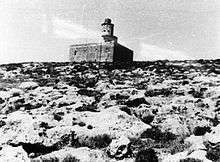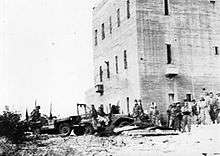Metzudat Koach
Coordinates: 33°06′53″N 35°33′22″E / 33.11472°N 35.55611°E

- This article is about the British Mandate-time police fort. For the depopulated Arab village after which it was named, see Al-Nabi Yusha'.
The Nabi Yusha fort, renamed Metzudat Koach (Hebrew: מצודת כ"ח), is a police fort built by the British Mandate administration during the 1936–39 Arab revolt in Palestine and currently used by the Israel Border Police.[1] The site around the fort contains a stone monument and a new museum[2] (founded in 2014), together constituting the Metzudat Koach Memorial, which commemorates 28 Israeli soldiers who died during the 1948 conquest of the strategically important fort[3]. The fort and observation point is located in the Upper Galilee, close to an abandoned Shia shrine of Nabi Yusha ("Prophet Joshua").[4] The Hebrew word "ko'ach" (כח) has a double meaning: as a common noun it means "strength", while its numerical value according to gematria is 28, the number of the fallen soldiers.
The Metzudat Koach memorial is currently part of the Israel National Trail.[1]
History
The building is a Tegart fort[5] commissioned by the British and constructed by Solel Boneh, the fort was a key observation point on the Naftali heights, overlooking the Hula Valley, and used to monitor the Palestine/Lebanon border.
By mid-April 1948, the British army had evacuated most of Upper Galilee. A number of key points were subsequently occupied by Arab forces, including the police fort at Nabi Yusha. This fort commanded the main road to Upper Galilee and the routes to the Jewish settlements of Ramot Naftali and Manara. The Palmach understood that this observation point had a strategic importance for the safety and future of the kibbutzim below.
In the evening hours of April 15, the police station was attacked by a company composed of Golani, Palmach and irregulars from nearby Jewish settlements, which moved in two armored cars and two armored Egged buses. Strong fire was opened on the attacking force which was compelled to withdraw. 4 Jews were killed.
On April 20, a second attempt was made to occupy the fort by a force from the third Palmach battalion. A small force succeeded in breaking the barriers and reaching the wall but two of its members were hit, which delayed the detonation of the explosives until their evacuation. During their evacuation, enemy fire was directed at them and many of the unit soldiers were killed. The troops fought to their last man. Altogether, 22 Jews were killed in the battle.
During the night of May 16/17, a company of the third battalion of the Yiftach Brigade occupied the fort after driving away their enemy. On the next day, two of the soldiers were killed.

In total, 28 Jewish soldiers fell in the battles for the occupation of the fort and "Metzudat HaKoach" ("Fort of the 28") is today named after them.[6]
The 28 soldiers
| Date | Name | Age | Rank | Birthplace[7] | |
|---|---|---|---|---|---|
| 20/04/48 | Ahali | Joseph | 20 | Corporal | Gedera |
| 20/04/48 | Akerman | Amnon | 19 | Private | Haifa |
| 20/04/48 | Amikam | Boaz | 19 | Private, paramedic | Haifa |
| 20/04/48 | Armoni | Yizhar | 18 | Private | Jerusalem |
| 20/4/48 | Barzilai | Aryeh | 19 | Private | Lithuania |
| 17/05/48 | Ben Bassat | Meir | 20 | Private | Bulgaria, Plovdiv |
| 13/05/48 | Ben Nevet | Eliezer | 21 | Corporal | Turkey |
| 20/02/48 | Cherkasky[8] | David | 22 | Lieutenant, Platoon commander | Haifa |
| 20/04/48 | Cohen | Avraham | 18 | Private | Jerusalem |
| 20/04/48 | Friedman | Philon[9] | 18 | Private | Poland |
| Futerman | Eliezer | 17 | |||
| 15/04/48 | Gutman | Joseph | 20 | Private | Tel Aviv |
| 20/04/48 | Horowitz | Zvi | 19 | Private | Haifa |
| 20/04/48 | Kochba | Hanan | 19 | Private | Germany |
| 22/04/48 | Levinsky | Yisrael | 19 | Private | Poland |
| 20/04/48 | Mizrachi | Shlomo | 19 | Private | Jerusalem |
| 20/04/48 | Moskowitz | Malachi | 19 | Private | Tel Aviv |
| 20/04/48 | Neeman | Moshe | 19 | Corporal | Tel Aviv |
| Ohali | Yosef | ||||
| 20/04/48 | Poterman | Eliezer | 18 | Corporal | Poland, Nova Korsha |
| 20/04/48 | Rauch | Mordechai | 26 | Private | Poland |
| 20/02/24 | Shevet | Eliezer | 20 | Private | Nahalal |
| 20/02/24 | Shwartz | David | 26 | Private | Czechoslovakia |
| 15/04/48 | Stashi | Moshe | 18 | Private | Bulgaria, Sofia |
| 20/04/48 | Tolitzinsky | Yuval | 19 | Private | Haifa |
| 20/04/48 | Wissotzky | Nehemia | 20 | Private | Jerusalem |
| 20/04/48 | Yekutieli | Amnon | 19 | Corporal, Squad commander | Jerusalem |
| 20/04/48 | Yizraelowitz | Yitczhak | 25 | Private | Poland |

External links
| Wikimedia Commons has media related to Metzudat Koach. |
References
- 1 2 The Koach Fortress by Peter Abelow
- ↑ Website of the HaReut Museum
- ↑ On the monument and inside the museum a Bible verse from 2 Samuel 1:19 is written (in Hebrew): "The beauty of Israel is slain upon thy high places. How are the mighty falllen."
- ↑ http://www.postcardsfromisrael.com/north.html Northern Exposure
- ↑ Roza el-Eini (2006). Mandated Landscape. Routledge. p. 486.
- ↑ palmach.org.il Palmach Info Center
- ↑ http://www.palmach.org.il/show_item.asp?itemId=8519&levelId=42855&itemType=0
- ↑ http://info.palmach.org.il/show_item.asp?levelId=42865&itemId=8591&itemType=0
- ↑ http://www.geni.com/people/Philon-Friedman/6000000002754129199